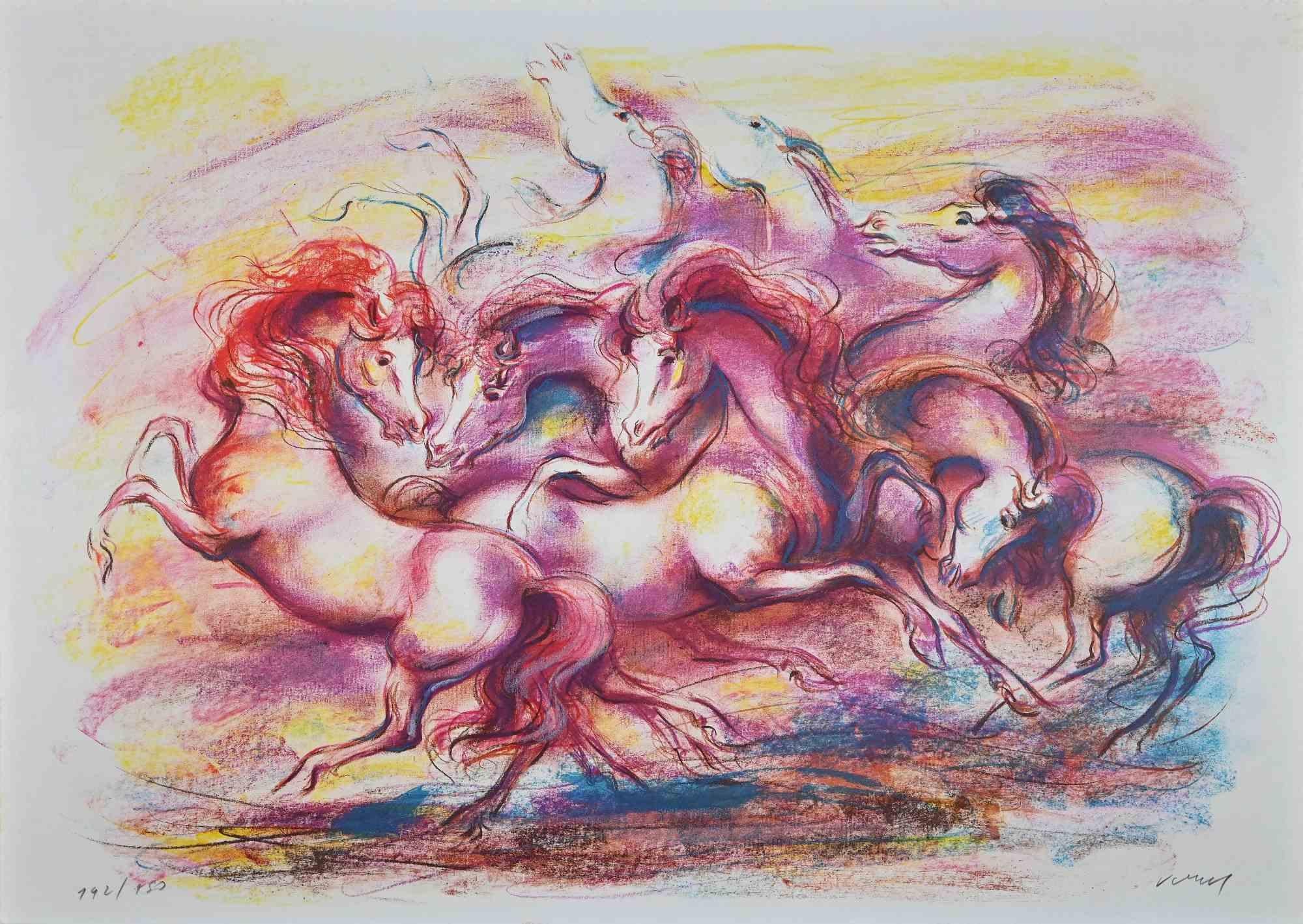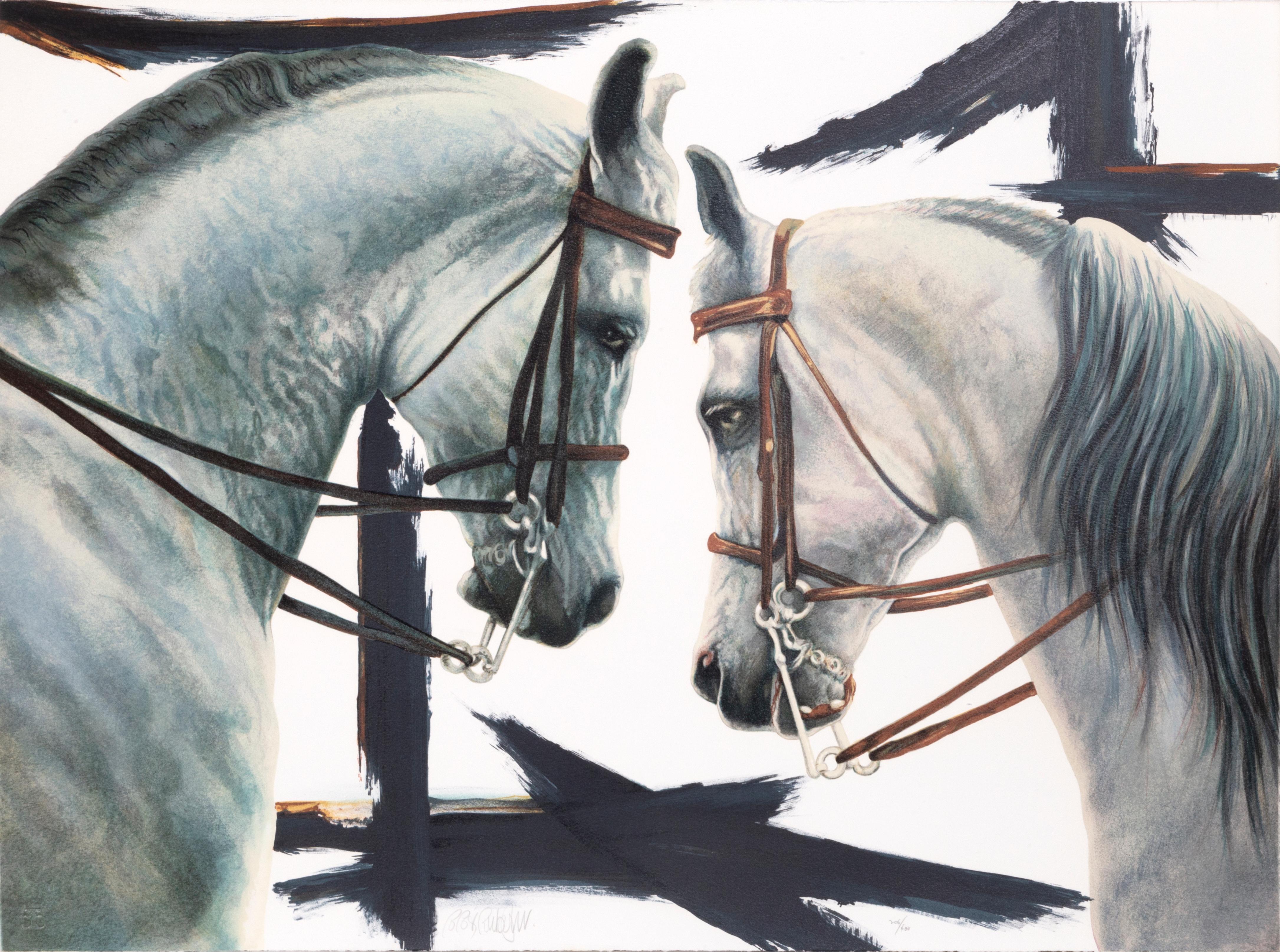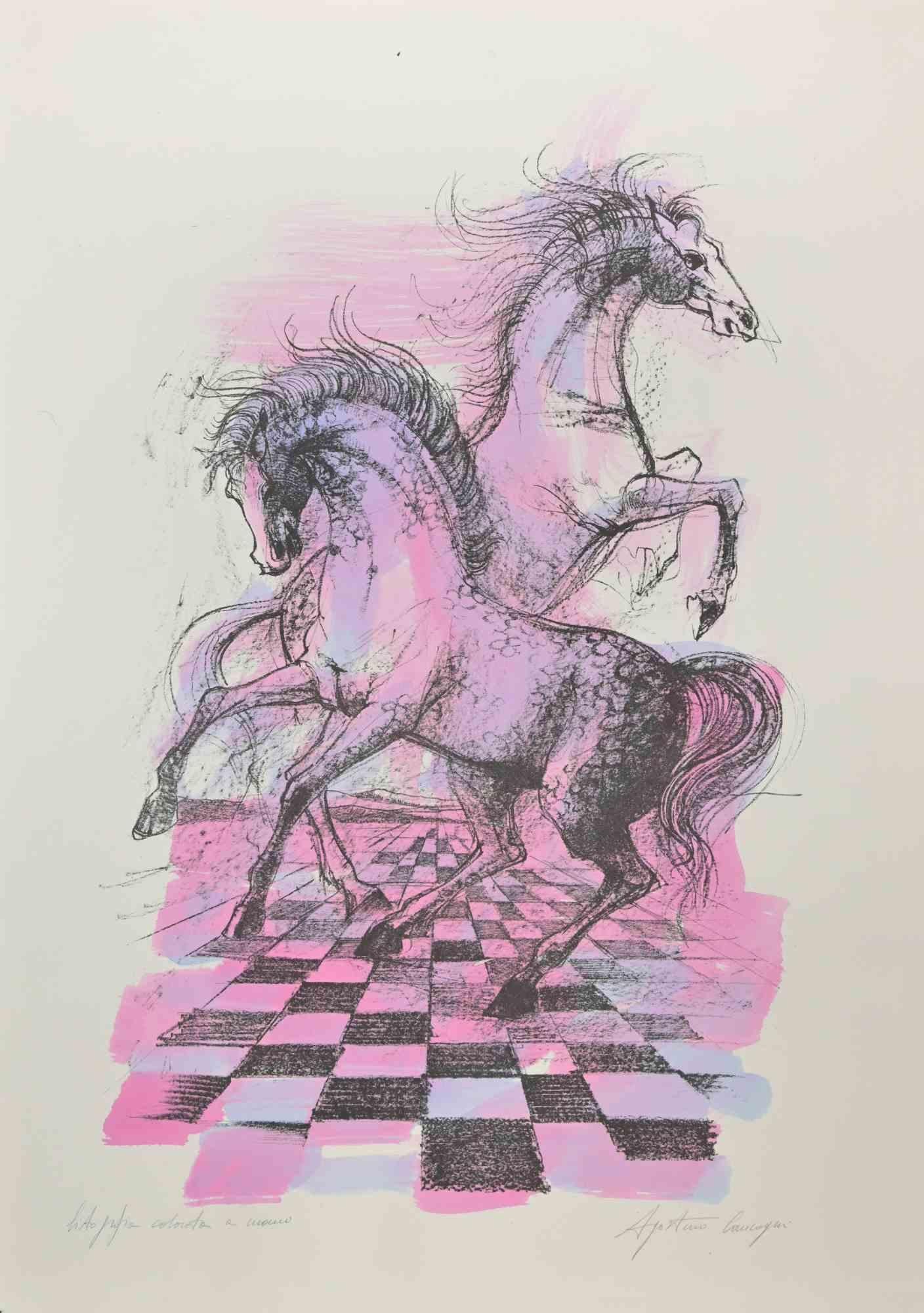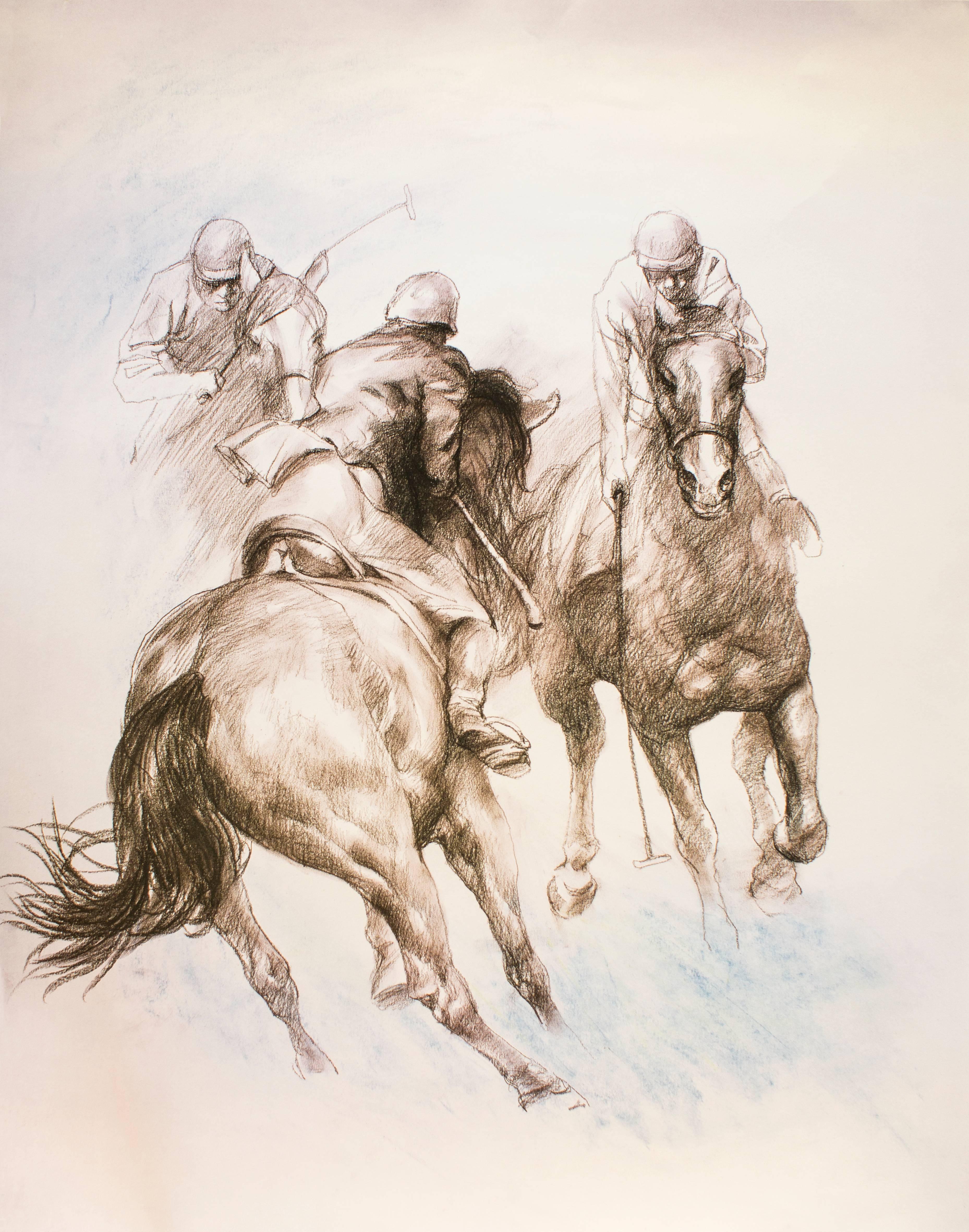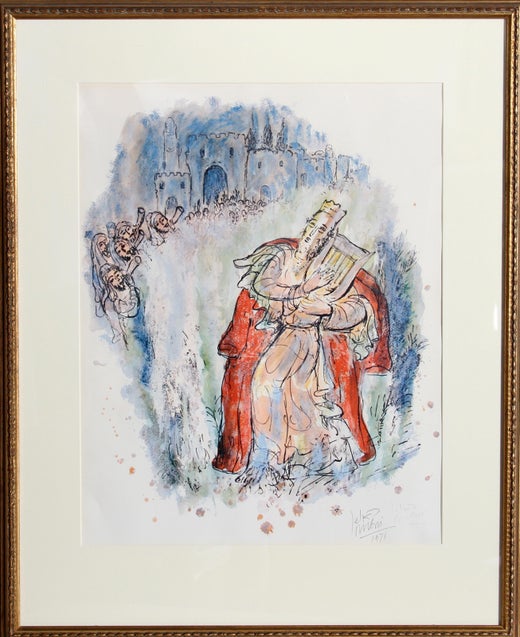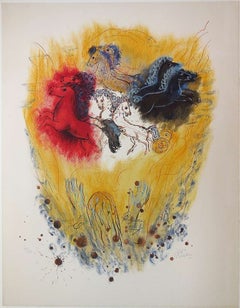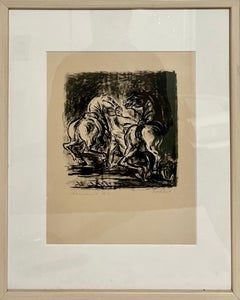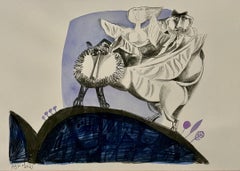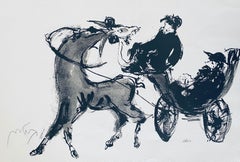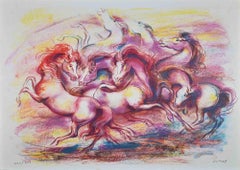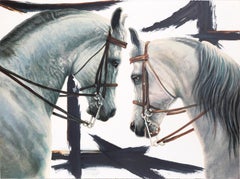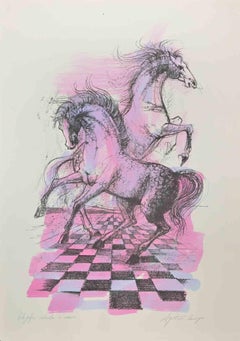Items Similar to Modern Israeli Lithograph Reuven Rubin Views Of Israel Judaica Horses, Riders
Want more images or videos?
Request additional images or videos from the seller
1 of 12
Reuven RubinModern Israeli Lithograph Reuven Rubin Views Of Israel Judaica Horses, Riders1960
1960
$800
£620.30
€703.84
CA$1,146.77
A$1,246.94
CHF 657.02
MX$15,146.76
NOK 8,260.04
SEK 7,743.12
DKK 5,281.72
About the Item
Lithograph printed by Chez Daniel Jacomet, Paris, France 1960 offset lithograph in colors on Arches, signed in crayon on the justification sheet (this auction is just for the one lithograph pictured as the 1st photo, the justification sheet with the original drawing is just included for provenance and is not part of this sale), on Arches deckle edged paper. limited edition of 250. plate signed and hand signed in pencil.
Israeli views Lithograph by Israeli Master.
Reuven Rubin 1893 -1974 was a Romanian-born Israeli painter and Israel's first ambassador to Romania.
Rubin Zelicovici (later Reuven Rubin) was born in Gala?i to a poor Romanian Jewish Hasidic family. He was the eighth of 13 children. In 1912, he left for Ottoman-ruled Palestine to study art at Bezalel Academy of Art and Design in Jerusalem. Finding himself at odds with the artistic views of the Academy's teachers, he left for Paris, France, in 1913 to pursue his studies at the École Nationale Supérieure des Beaux-Arts. At the outbreak of World War I, he was returned to Romania, where he spent the war years.
In 1921, he traveled to the United States with his friend and fellow artist, Arthur Kolnik, with whom he had shared a studio in Cernovitzu. In New York City, the two met artist Alfred Stieglitz, who was instrumental in organizing their first American show at the Anderson Gallery.Following the exhibition, in 1922, they both returned to Europe. In 1923, Rubin emigrated to Mandate Palestine.
Rubin met his wife, Esther, in 1928, aboard a passenger ship to Palestine on his return from a show in New York. She was a Bronx girl who had won a trip to Palestine in a Young Judea competition. He died in 1974
Artistic career
Joseph Zaritsky, Arieh Lubin, Yona Zeliuk, Reuven Rubin, Sionah Tagger, Pinchas Litvinovsky, Yitzhak Katz, and Baruch Agadati; The painters who depicted the country’s landscapes in the 1920s rebelled against Bezalel. They sought current styles in Europe that would help portray their own country’s landscape, in keeping with the spirit of the time. Rubin’s Cezannesque landscapes from the 1920s were defined by both a modern and a naive style, portraying the landscape and inhabitants of Israel in a sensitive fashion. His landscape paintings in particular paid special detail to a spiritual, translucent light.
In Palestine, he became one of the founders of the new Eretz-Yisrael style. Recurring themes in his work were the bible, the prophet, the biblical landscape, folklore and people, including Yemenite, Hasidic Jews and Arabs. Many of his paintings are sun-bathed depictions of Jerusalem and the Galilee. Rubin might have been influenced by the work of Henri Rousseau whose style combined with Eastern nuances, as well as with the neo-Byzantine art to which Rubin had been exposed in his native Romania. In accordance with his integrative style, he signed his works with his first name in Hebrew and his surname in Roman letters.
In 1924, he was the first artist to hold a solo exhibition at the Tower of David, in Jerusalem (later exhibited in Tel Aviv at Gymnasia Herzliya). That year he was elected chairman of the Association of Painters and Sculptors of Palestine. From the 1930s onwards, Rubin designed backdrops for Habima Theater, the Ohel Theater and other theaters.
His biography, published in 1969, is titled My Life - My Art. He died in Tel Aviv in October 1974, after having bequeathed his home on 14 Bialik Street and a core collection of his paintings to the city of Tel Aviv. The Rubin Museum opened in 1983. The director and curator of the museum is his daughter-in-law, Carmela Rubin.Rubin's paintings are now increasingly sought after. At a Sotheby's auction in New York in 2007, his work accounted for six of the ten top lots.
Selected group exhibitions:
2015 Israeli Art: The Renewed Collection Galleries, Dr. Julius and Hilde Merzbacher Galleries and the Ayala Zacks Abramov Pavilion for Israeli Art, Israel Museum, Jerusalem
Artists: Reuven Rubin, Ephraim Moses Lilien, Yitzhak Danziger, Lea Nikel, Naftali Bezem, Mordecai Ardon, David Reeb, Ruth Schloss, Yehiel Shemi, Menashe Kadishman, Avigdor Arikha, Moshe Gershuni, Moshe Geva, Tsibi Ginton, David Gitlin, Michael Klapisch, Liliane Klasmer, Gabi Krakauer, Leopold Moshe Kupferman, Sigalit Landau, Moshe Mokady, Ori Reisman, Yehezkel Streichman, Anna Ticho, Sionah Tagger and others.
Education
1912 Bezalel Academy of Arts and Design, Jerusalem
1913-14 École des Beaux Arts, Paris and Académie Colarossi, Paris
- Creator:Reuven Rubin (1893 - 1974, Israeli)
- Creation Year:1960
- Dimensions:Height: 25.5 in (64.77 cm)Width: 19.5 in (49.53 cm)
- Medium:
- Movement & Style:
- Period:
- Condition:good. minor toning.
- Gallery Location:Surfside, FL
- Reference Number:1stDibs: LU38214091072
Reuven Rubin
Reuven Rubin- (November 13, 1893 - October 13, 1974) was a Romanian-born Israeli painter and Israel's first ambassador to Romania. Rubin Zelicovici (later Reuven Rubin) was born in Galaţi to a poor Romanian Jewish Hasidic family. He was the eighth of 13 children. In 1912, he left for Ottoman-ruled Palestine to study art at Bezalel Academy of Art and Design in Jerusalem. Finding himself at odds with the artistic views of the Academy's teachers, he left for Paris, France, in 1913 to pursue his studies at the École Nationale Supérieure des Beaux-Arts. At the outbreak of World War I, he was returned to Romania, where he spent the war years.
In 1921, he traveled to the United States with his friend and fellow artist, Arthur Kolnik, with whom he had shared a studio in Cernăuţi. In New York City, the two met artist Alfred Stieglitz, who was instrumental in organizing their first American show at the Anderson Gallery. Following the exhibition, in 1922, they both returned to Europe. In 1923, Rubin emigrated to Mandate Palestine.
Rubin met his wife, Esther, in 1928, aboard a passenger ship to Palestine on his return from a show in New York. She was a Bronx girl who had won a trip to Palestine in a Young Judea competition. He died in 1974.
About the Seller
4.9
Platinum Seller
Premium sellers with a 4.7+ rating and 24-hour response times
Established in 1995
1stDibs seller since 2014
1,824 sales on 1stDibs
Typical response time: 1 hour
- ShippingRetrieving quote...Shipping from: Surfside, FL
- Return Policy
Authenticity Guarantee
In the unlikely event there’s an issue with an item’s authenticity, contact us within 1 year for a full refund. DetailsMoney-Back Guarantee
If your item is not as described, is damaged in transit, or does not arrive, contact us within 7 days for a full refund. Details24-Hour Cancellation
You have a 24-hour grace period in which to reconsider your purchase, with no questions asked.Vetted Professional Sellers
Our world-class sellers must adhere to strict standards for service and quality, maintaining the integrity of our listings.Price-Match Guarantee
If you find that a seller listed the same item for a lower price elsewhere, we’ll match it.Trusted Global Delivery
Our best-in-class carrier network provides specialized shipping options worldwide, including custom delivery.More From This Seller
View AllBible Lithograph, Chariot of Elijah
By Reuven Rubin
Located in Surfside, FL
Lithograph printed by Mourlot, Paris on Arches France paper. limited edition of 150. Pencil signed. image of Horses with Chariot. (I believe it is from Elijah)
Biblical themed Litho...
Category
1970s Figurative Prints
Materials
Archival Paper, Lithograph
1916 German Expressionism Figurative Lithograph Man Two Horses Paul Kleinschmidt
By Paul Kleinschmidt
Located in Surfside, FL
Paul Kleinschmidt, (1883–1949)
"Man & Two Horses" Lithograph
1916
Frame: 21" X 17"
Image: 13.5" X 10.5"
Rare Artist's Proof
Provenance: bears labels from ACA Galleries and Richard ...
Category
1910s Abstract Figurative Prints
Materials
Lithograph
Rare Israeli Modernist Judaica Watercolor Painting on Lithograph Naftali Bezem
By Naftali Bezem
Located in Surfside, FL
Naftali Bezem (Hebrew: נפתלי בזם; born November 27, 1924) is an Israeli painter, muralist, and sculptor.
Bezem was born in Essen, Germany, in 1924. His early adolescence was spent ...
Category
20th Century Modern Figurative Drawings and Watercolors
Materials
Watercolor, Lithograph
Polish Israeli Artist Expressionist Hand Signed Lithograph
By Moshe Bernstein
Located in Surfside, FL
Born in Poland in 1920, Bernstein completed his art studies in the Academy of Vilna in 1939. His family was wiped out in the Holocaust, but he survived the war and lived in Russia un...
Category
Mid-20th Century Expressionist Prints and Multiples
Materials
Lithograph
Circus Girl with Horses Lithograph with Hand Coloring
By Marcel Vertès
Located in Surfside, FL
This is an original hand signed (I believe it is also hand colored but i am not positive) Artists Proof Lithograph of a Circus scene. This depicts a circus girl with horses.
This ca...
Category
1940s Post-Impressionist Animal Prints
Materials
Watercolor, Lithograph
Israeli Surrealist Abstract Lithograph Naftali Bezem
By Naftali Bezem
Located in Surfside, FL
Naftali Bezem (Hebrew: נפתלי בזם; born November 27, 1924) is an Israeli painter, muralist, and sculptor.
Bezem was born in Essen, Germany, in 1924. His early adolescence was spent...
Category
20th Century Modern Prints and Multiples
Materials
Lithograph
You May Also Like
The Dance Of Horses - Original Lithograph by Jovan Vulic - 1980s
By Jovan Vulic
Located in Roma, IT
The Dance Of Horses is a beautiful colored lithograph on paper, realized in the 1980s by the artist Jovan Vulic (b. 1951).
Hand-signed and numbered in pencil on the lower margin. ...
Category
1980s Contemporary Figurative Prints
Materials
Lithograph
Horses, Contemporary Equestrian Lithograph by Popo and Ruby Lee
By Popo and Ruby Lee
Located in Long Island City, NY
Artist: Popo and Ruby Lee
Title: Horses
Year: circa 1980
Medium: Lithograph, signed and numbered in pencil
Edition: 206/400
Size: 24 x 32 in. (60.96 x 81.28 cm)
Category
1980s Contemporary Animal Prints
Materials
Lithograph
Free Horses - Lithograph by Agostino Cancogni - 1980s
Located in Roma, IT
Free Horses is a beautiful lithograph realized by Agostino Cancogni in the 1980s.
Hand-watercolored lithograph on paper. Unique specimen.
Personally colored by the artist and hand...
Category
1980s Contemporary Animal Prints
Materials
Lithograph
Horses : Riders in Autumn - Original Lithograph, HANDSIGNED & Ltd /600
Located in Paris, IDF
Serge LASSUS (1933-)
Horses : Riders in Autumn, 1983
Original Lithograph
Handsigned in pencil
Numbered / 600 (the number you can see can be different)
On Coated paper 56 x 76 cm (c....
Category
1980s Modern Landscape Prints
Materials
Lithograph
Zungaro (Horse and Acrobats at the Circus) - Original handsigned lithograph
By Claude Weisbuch
Located in Paris, IDF
Claude WEISBUCH
Zungaro : Horse and acrobats at the circus
Original lithograph
Handsigned in pencil
Limited /200copies
On vellum 76 x 58 cm (c. 30 x 23 in)
Excellent condition
Category
Late 20th Century Modern Figurative Prints
Materials
Lithograph
Equestrian - Lithograph by Zhou Zhiwei - 2008
By Zhou Zhiwei
Located in Roma, IT
Hand signed.
Editions of 260 prints numbered and hand signed.
Excellent conditions.
Zhou Zhiwei
He was born in Shangai in 1954 and started to paint when he was 9 years old.
he was a disciple of two famous chinese painters...
Category
Early 2000s Contemporary Figurative Prints
Materials
Lithograph
More Ways To Browse
Andy Warhol Invitation
Angel Zarraga
Antique Boat Motors
Antique Mermaid Print
Bonnard Etching
Carlos Bastos
Chagall Creation
Chagall Etching Watercolor
Chagall Maternite
Christinas World
Cries Of London
Dali Carmen
Dali Cavalier
Dali Horse Lithograph
Dali Japanese
Dali Paradise Canto
David Hockney Olympics
Decameron Dali
